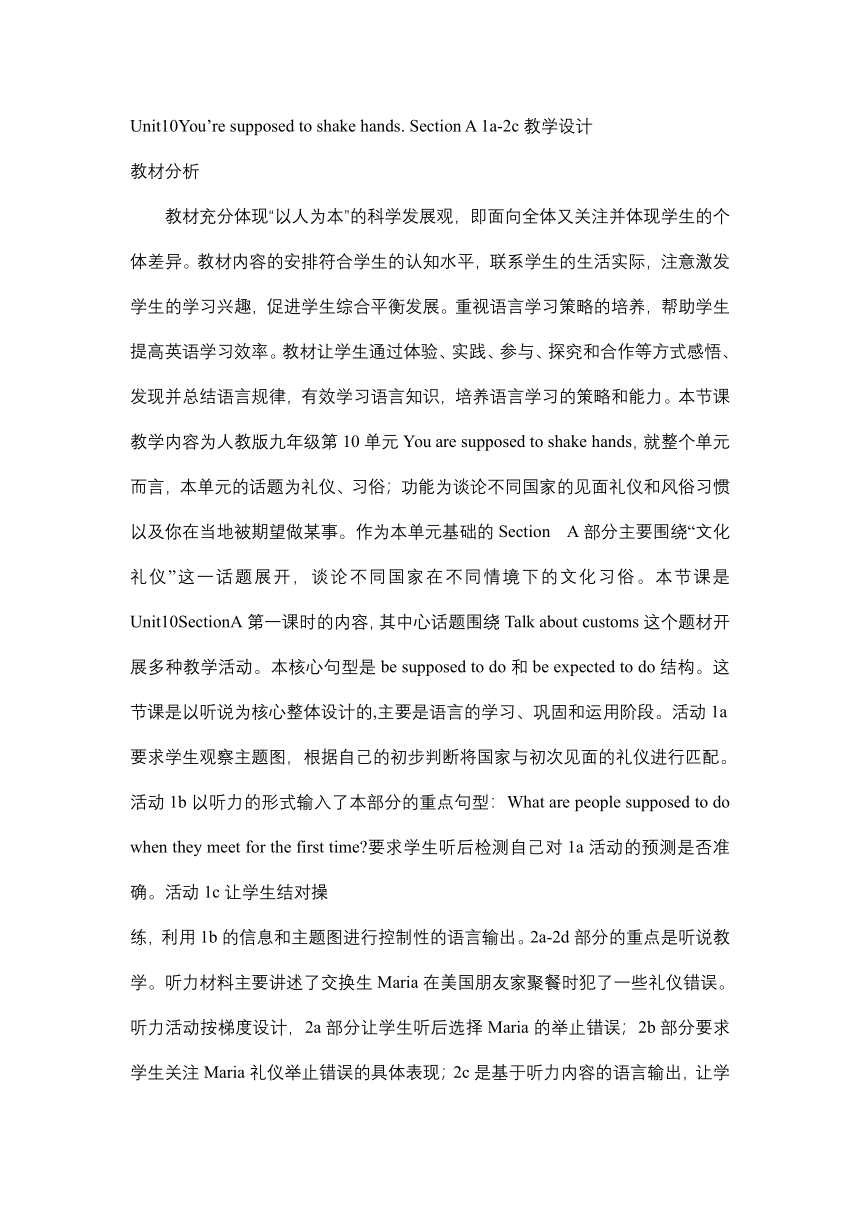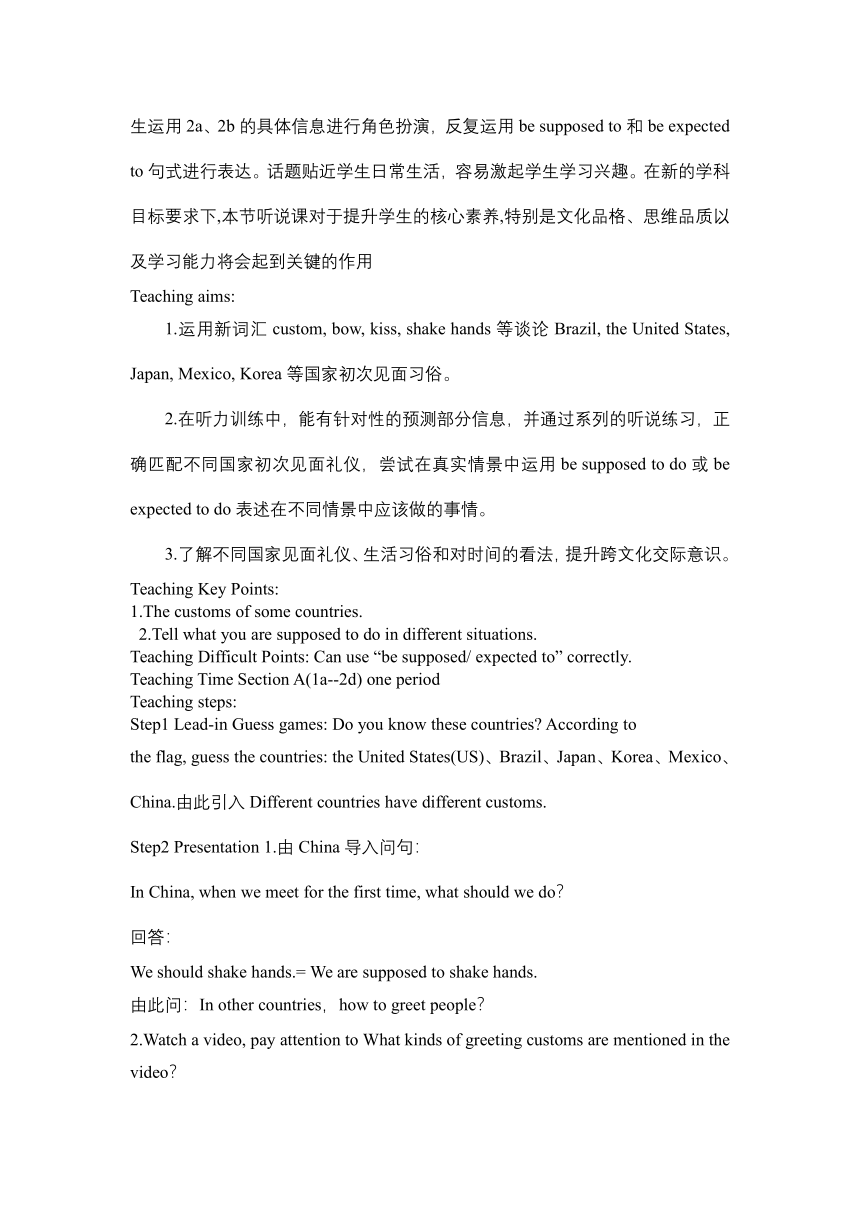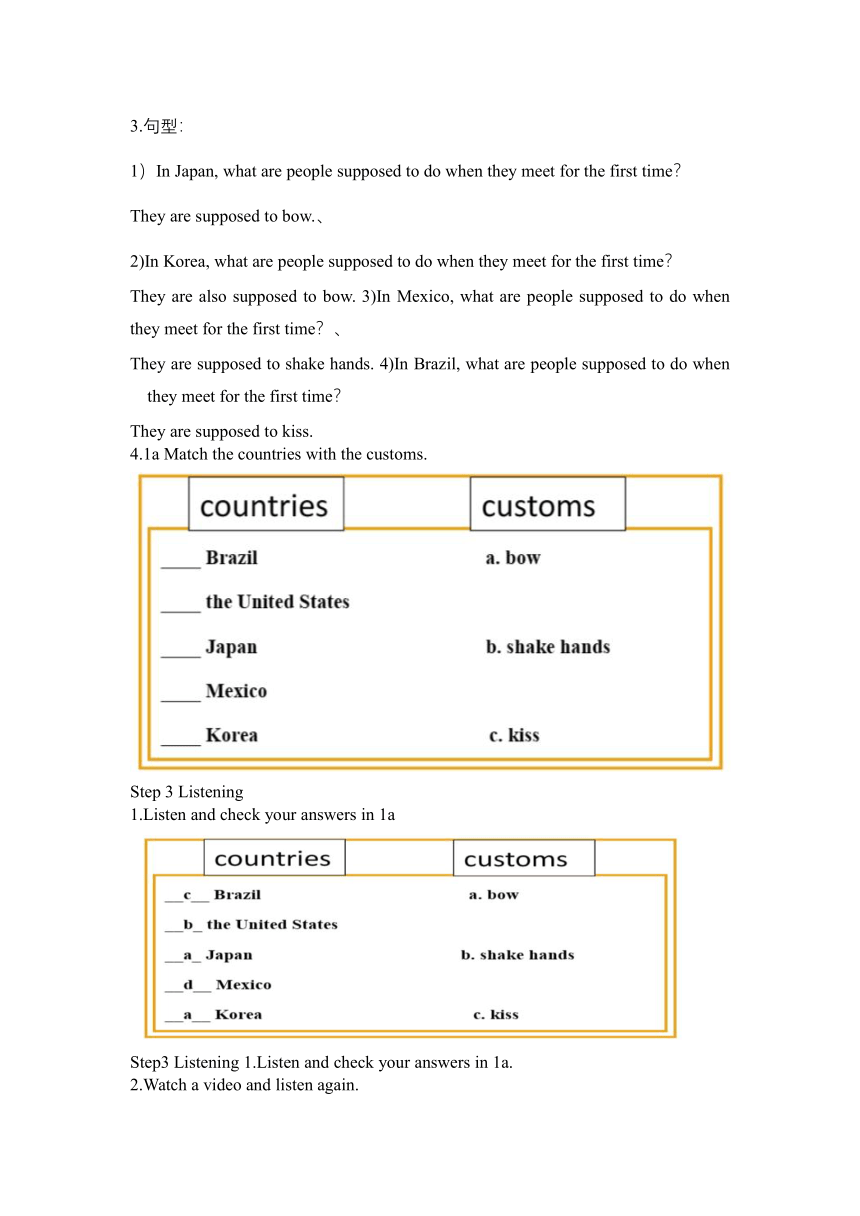Unit 10 You're supposed to shake hands. Section A 1a~2c教学设计-2023-2024学年人教新目标九年级英语全册
文档属性
| 名称 | Unit 10 You're supposed to shake hands. Section A 1a~2c教学设计-2023-2024学年人教新目标九年级英语全册 |

|
|
| 格式 | docx | ||
| 文件大小 | 195.4KB | ||
| 资源类型 | 教案 | ||
| 版本资源 | 人教新目标(Go for it)版 | ||
| 科目 | 英语 | ||
| 更新时间 | 2024-05-09 12:35:53 | ||
图片预览



文档简介
Unit10You’re supposed to shake hands. Section A 1a-2c教学设计
教材分析
教材充分体现“以人为本”的科学发展观,即面向全体又关注并体现学生的个体差异。教材内容的安排符合学生的认知水平,联系学生的生活实际,注意激发学生的学习兴趣,促进学生综合平衡发展。重视语言学习策略的培养,帮助学生提高英语学习效率。教材让学生通过体验、实践、参与、探究和合作等方式感悟、发现并总结语言规律,有效学习语言知识,培养语言学习的策略和能力。本节课教学内容为人教版九年级第10单元You are supposed to shake hands,就整个单元而言,本单元的话题为礼仪、习俗;功能为谈论不同国家的见面礼仪和风俗习惯以及你在当地被期望做某事。作为本单元基础的Section A部分主要围绕“文化礼仪”这一话题展开,谈论不同国家在不同情境下的文化习俗。本节课是Unit10SectionA第一课时的内容,其中心话题围绕Talk about customs这个题材开展多种教学活动。本核心句型是be supposed to do和be expected to do结构。这节课是以听说为核心整体设计的,主要是语言的学习、巩固和运用阶段。活动1a要求学生观察主题图,根据自己的初步判断将国家与初次见面的礼仪进行匹配。活动1b以听力的形式输入了本部分的重点句型:What are people supposed to do when they meet for the first time 要求学生听后检测自己对1a活动的预测是否准确。活动1c让学生结对操
练,利用1b的信息和主题图进行控制性的语言输出。2a-2d部分的重点是听说教学。听力材料主要讲述了交换生Maria在美国朋友家聚餐时犯了一些礼仪错误。听力活动按梯度设计,2a部分让学生听后选择Maria的举止错误;2b部分要求学生关注Maria礼仪举止错误的具体表现;2c是基于听力内容的语言输出,让学生运用2a、2b的具体信息进行角色扮演,反复运用be supposed to和be expected to句式进行表达。话题贴近学生日常生活,容易激起学生学习兴趣。在新的学科目标要求下,本节听说课对于提升学生的核心素养,特别是文化品格、思维品质以及学习能力将会起到关键的作用
Teaching aims:
1.运用新词汇custom, bow, kiss, shake hands等谈论Brazil, the United States, Japan, Mexico, Korea等国家初次见面习俗。
2.在听力训练中,能有针对性的预测部分信息,并通过系列的听说练习,正确匹配不同国家初次见面礼仪,尝试在真实情景中运用be supposed to do或be expected to do表述在不同情景中应该做的事情。
3.了解不同国家见面礼仪、生活习俗和对时间的看法,提升跨文化交际意识。Teaching Key Points:
1.The customs of some countries.
2.Tell what you are supposed to do in different situations.
Teaching Difficult Points: Can use “be supposed/ expected to” correctly.
Teaching Time Section A(1a--2d) one period
Teaching steps:
Step1 Lead-in Guess games: Do you know these countries According to
the flag, guess the countries: the United States(US)、Brazil、Japan、Korea、Mexico、China.由此引入Different countries have different customs.
Step2 Presentation 1.由China导入问句:
In China, when we meet for the first time, what should we do?
回答:
We should shake hands.= We are supposed to shake hands.
由此问:In other countries,how to greet people?
2.Watch a video, pay attention to What kinds of greeting customs are mentioned in the video?
3.句型:
1)In Japan, what are people supposed to do when they meet for the first time?
They are supposed to bow.、
2)In Korea, what are people supposed to do when they meet for the first time?
They are also supposed to bow. 3)In Mexico, what are people supposed to do when they meet for the first time?、
They are supposed to shake hands. 4)In Brazil, what are people supposed to do when they meet for the first time?
They are supposed to kiss.
4.1a Match the countries with the customs.
Step 3 Listening
1.Listen and check your answers in 1a
Step3 Listening 1.Listen and check your answers in 1a.
2.Watch a video and listen again.
Step4 Pair work Make a conversation about what people in different countries do when they meet for the first time. Talk about the countries in 1a or other countries.
A: In Korea, what are people supposed to do when they meet for the first time
B: They are supposed to bow. How about in the United States
A: In the United States, they are expected to shake hands
They are supposed /excepted to__________.
Step 6 Listening 1. Look at the picture in 2a
Answer: What kind of party is it
A. An indoor party.
B. An outdoor party.、
Then think about: What do you know about outdoor parties 、What are people supposed to do at outdoor parties
2.Maria is an exchange student. Last night she had dinner at an American friend’s house. Listen and check(√) the mistakes Maria made
3.2b. Listen again. Fill in the blank
1.Maria was supposed to arrive at 7:00, but she_____________.
2.In Maria’s country, when you’re invited for 7:00, you’re expected to___________.、
3.When Maria met Paul’s mom, she was supposed to___________.
4.Maria should ask what she is supposed to _______if she is invited to a party next time
4.Listen and read.、Daisy: Hi, Maria. How was Paul’s party
Maria: Oh, Daisy, it was terrible.、
Daisy: It was
Maria: Uh-huh.
Daisy: What happened 、Maria: Well, Iwas supposed to arrive at 7:00, but I arrived at 8:00. Daisy: Oh,so you were late. Maria: Yeah, but in my country, it’s different. When you’re invited for7:00, you are expected to come later! It’s considered strange to turn up on time.
Daisy: I see.
Maria: Then when I met Paul’s mom, I kissed her. Daisy: Oh...you were supposed to shake hands instead. Maria: That’s right. And I wore a fancy dress.
Daisy: What’s wrong with that Maria: Well, it turned out that it was an outdoor party,
4.Maria should ask what she is supposed to _______if she is invited to a party next time.
Daisy. Everyone else was in a T-shirt and jeans. Daisy: I guess next time you should ask what you’re supposed to wear.
Step 6 Groupwork 1.Compare and finish the chart.\
2.Make a report using the information in the chart. You can report like this: In America, people are supposed to..., but in Maria’s country, she is expected to... (Time/ Greeting / Dressing)
3.Watch a video. Know more about customs in America.
Step 7 Summary What have you learnt in this class
Step8 Homework
1.Compare the customs in China and in Western countries.
2Write something about ways of greeting in different countries.
课后反思
从本节课课堂反馈来看,通过小组合作的方式,并借助多媒体,增加趣味性和直观性,增大课堂容量,提高课堂效率,课堂实施效果比较理想,学生能够积极的参与到课堂中来并能做到有所思有所表达,教学目标基本达成。基于现场上课的实况,授课教师对本节课进行了深刻的反思,总结出以下几点:
1.从课堂表现来看,这堂课基本用全英语授课,导致基础不是太好的学生在理解上有些困难,从而不能很好的听懂老师的要求,课堂气氛有时不够活跃,不过,学生在教学指导下,能够掌握和运用了一些听力技巧,如听前读图、听前预测、听时速记等,学生能够顺利地完成了各项听力任务。
2.在听力过程中不仅要关注听的结果,还要侧重听的过程。教师在听力教学过程中精心设计了形式多样的练习活动,针对学生某些听力技能的不足,做到强化训练,循序渐进,各个击破。在听说课教学中,要优化教学设计,选择和设计有针对性的听力与口语教学活动。所以,教师在有限的课堂教学时间内进行了取舍,选择有针对性的听力与口语教学活动。
3.通过小组讨论培养学生的合作能力。注重培养学生的语言输出技能,锻炼学生听与说的能力。提问面广,学生参与面大,师生配合良好。
4.在教学过程中要给与学生适时地评价,评价是无形的激励,恰当的评价能促进学生进行跟高水平的展示。纵观这节课,在评价方面有欠缺,过于单一了。
教材分析
教材充分体现“以人为本”的科学发展观,即面向全体又关注并体现学生的个体差异。教材内容的安排符合学生的认知水平,联系学生的生活实际,注意激发学生的学习兴趣,促进学生综合平衡发展。重视语言学习策略的培养,帮助学生提高英语学习效率。教材让学生通过体验、实践、参与、探究和合作等方式感悟、发现并总结语言规律,有效学习语言知识,培养语言学习的策略和能力。本节课教学内容为人教版九年级第10单元You are supposed to shake hands,就整个单元而言,本单元的话题为礼仪、习俗;功能为谈论不同国家的见面礼仪和风俗习惯以及你在当地被期望做某事。作为本单元基础的Section A部分主要围绕“文化礼仪”这一话题展开,谈论不同国家在不同情境下的文化习俗。本节课是Unit10SectionA第一课时的内容,其中心话题围绕Talk about customs这个题材开展多种教学活动。本核心句型是be supposed to do和be expected to do结构。这节课是以听说为核心整体设计的,主要是语言的学习、巩固和运用阶段。活动1a要求学生观察主题图,根据自己的初步判断将国家与初次见面的礼仪进行匹配。活动1b以听力的形式输入了本部分的重点句型:What are people supposed to do when they meet for the first time 要求学生听后检测自己对1a活动的预测是否准确。活动1c让学生结对操
练,利用1b的信息和主题图进行控制性的语言输出。2a-2d部分的重点是听说教学。听力材料主要讲述了交换生Maria在美国朋友家聚餐时犯了一些礼仪错误。听力活动按梯度设计,2a部分让学生听后选择Maria的举止错误;2b部分要求学生关注Maria礼仪举止错误的具体表现;2c是基于听力内容的语言输出,让学生运用2a、2b的具体信息进行角色扮演,反复运用be supposed to和be expected to句式进行表达。话题贴近学生日常生活,容易激起学生学习兴趣。在新的学科目标要求下,本节听说课对于提升学生的核心素养,特别是文化品格、思维品质以及学习能力将会起到关键的作用
Teaching aims:
1.运用新词汇custom, bow, kiss, shake hands等谈论Brazil, the United States, Japan, Mexico, Korea等国家初次见面习俗。
2.在听力训练中,能有针对性的预测部分信息,并通过系列的听说练习,正确匹配不同国家初次见面礼仪,尝试在真实情景中运用be supposed to do或be expected to do表述在不同情景中应该做的事情。
3.了解不同国家见面礼仪、生活习俗和对时间的看法,提升跨文化交际意识。Teaching Key Points:
1.The customs of some countries.
2.Tell what you are supposed to do in different situations.
Teaching Difficult Points: Can use “be supposed/ expected to” correctly.
Teaching Time Section A(1a--2d) one period
Teaching steps:
Step1 Lead-in Guess games: Do you know these countries According to
the flag, guess the countries: the United States(US)、Brazil、Japan、Korea、Mexico、China.由此引入Different countries have different customs.
Step2 Presentation 1.由China导入问句:
In China, when we meet for the first time, what should we do?
回答:
We should shake hands.= We are supposed to shake hands.
由此问:In other countries,how to greet people?
2.Watch a video, pay attention to What kinds of greeting customs are mentioned in the video?
3.句型:
1)In Japan, what are people supposed to do when they meet for the first time?
They are supposed to bow.、
2)In Korea, what are people supposed to do when they meet for the first time?
They are also supposed to bow. 3)In Mexico, what are people supposed to do when they meet for the first time?、
They are supposed to shake hands. 4)In Brazil, what are people supposed to do when they meet for the first time?
They are supposed to kiss.
4.1a Match the countries with the customs.
Step 3 Listening
1.Listen and check your answers in 1a
Step3 Listening 1.Listen and check your answers in 1a.
2.Watch a video and listen again.
Step4 Pair work Make a conversation about what people in different countries do when they meet for the first time. Talk about the countries in 1a or other countries.
A: In Korea, what are people supposed to do when they meet for the first time
B: They are supposed to bow. How about in the United States
A: In the United States, they are expected to shake hands
They are supposed /excepted to__________.
Step 6 Listening 1. Look at the picture in 2a
Answer: What kind of party is it
A. An indoor party.
B. An outdoor party.、
Then think about: What do you know about outdoor parties 、What are people supposed to do at outdoor parties
2.Maria is an exchange student. Last night she had dinner at an American friend’s house. Listen and check(√) the mistakes Maria made
3.2b. Listen again. Fill in the blank
1.Maria was supposed to arrive at 7:00, but she_____________.
2.In Maria’s country, when you’re invited for 7:00, you’re expected to___________.、
3.When Maria met Paul’s mom, she was supposed to___________.
4.Maria should ask what she is supposed to _______if she is invited to a party next time
4.Listen and read.、Daisy: Hi, Maria. How was Paul’s party
Maria: Oh, Daisy, it was terrible.、
Daisy: It was
Maria: Uh-huh.
Daisy: What happened 、Maria: Well, Iwas supposed to arrive at 7:00, but I arrived at 8:00. Daisy: Oh,so you were late. Maria: Yeah, but in my country, it’s different. When you’re invited for7:00, you are expected to come later! It’s considered strange to turn up on time.
Daisy: I see.
Maria: Then when I met Paul’s mom, I kissed her. Daisy: Oh...you were supposed to shake hands instead. Maria: That’s right. And I wore a fancy dress.
Daisy: What’s wrong with that Maria: Well, it turned out that it was an outdoor party,
4.Maria should ask what she is supposed to _______if she is invited to a party next time.
Daisy. Everyone else was in a T-shirt and jeans. Daisy: I guess next time you should ask what you’re supposed to wear.
Step 6 Groupwork 1.Compare and finish the chart.\
2.Make a report using the information in the chart. You can report like this: In America, people are supposed to..., but in Maria’s country, she is expected to... (Time/ Greeting / Dressing)
3.Watch a video. Know more about customs in America.
Step 7 Summary What have you learnt in this class
Step8 Homework
1.Compare the customs in China and in Western countries.
2Write something about ways of greeting in different countries.
课后反思
从本节课课堂反馈来看,通过小组合作的方式,并借助多媒体,增加趣味性和直观性,增大课堂容量,提高课堂效率,课堂实施效果比较理想,学生能够积极的参与到课堂中来并能做到有所思有所表达,教学目标基本达成。基于现场上课的实况,授课教师对本节课进行了深刻的反思,总结出以下几点:
1.从课堂表现来看,这堂课基本用全英语授课,导致基础不是太好的学生在理解上有些困难,从而不能很好的听懂老师的要求,课堂气氛有时不够活跃,不过,学生在教学指导下,能够掌握和运用了一些听力技巧,如听前读图、听前预测、听时速记等,学生能够顺利地完成了各项听力任务。
2.在听力过程中不仅要关注听的结果,还要侧重听的过程。教师在听力教学过程中精心设计了形式多样的练习活动,针对学生某些听力技能的不足,做到强化训练,循序渐进,各个击破。在听说课教学中,要优化教学设计,选择和设计有针对性的听力与口语教学活动。所以,教师在有限的课堂教学时间内进行了取舍,选择有针对性的听力与口语教学活动。
3.通过小组讨论培养学生的合作能力。注重培养学生的语言输出技能,锻炼学生听与说的能力。提问面广,学生参与面大,师生配合良好。
4.在教学过程中要给与学生适时地评价,评价是无形的激励,恰当的评价能促进学生进行跟高水平的展示。纵观这节课,在评价方面有欠缺,过于单一了。
同课章节目录
- Unit 1 How can we become good learners.
- Section A
- Section B
- Unit 2 I think that mooncakes are delicious!
- Section A
- Section B
- Unit 3 Could you please tell me where the restroom
- Section A
- Section B
- Unit 4 I used to be afraid of the dark.
- Section A
- Section B
- Unit 5 What are the shirts made of?
- Section A
- Section B
- Review of Units 1-5
- Unit 6 When was it invented?
- Section A
- Section B
- Unit 7 Teenagers should be allowed to choose their
- Section A
- Section B
- Unit 8 It must belong to Carla.
- Section A
- Section B
- Unit 9 I like music that I can dance to.
- Section A
- Section B
- Unit 10 You're supposed to shake hands.
- Section A
- Section B
- Review of Units 6-10
- Unit 11 Sad movies make me cry.
- Section A
- Section B
- Unit 12 Life is full of the unexpected
- Section A
- Section B
- Unit 13 We're trying to save the earth!
- Section A
- Section B
- Unit 14 I remember meeting all of you in Grade 7.
- Section A
- Section B
- Review of Units 11-14
